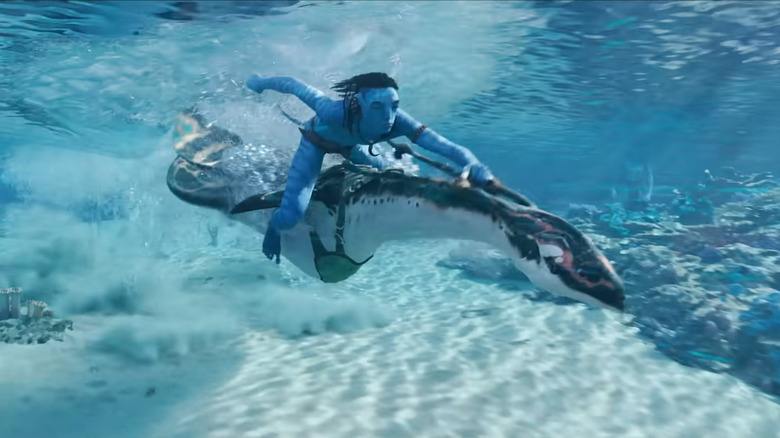How Avatar: The Way Of Water Made Riding An Alien Creature Look As Real As Possible
James Cameron's "Avatar: The Way of Water" is a sequel 13 years in the making, continuing the story of Pandora, a distant, blue planet populated by distant, blue people. Although the narratives around displacement and colonization can be compared to other popular films, like Disney's "Pocahontas," the original "Avatar" marked the culmination of cinematic innovation that no other film could claim credit for. Among other things, Cameron revolutionized the art of motion capture (a process by which physical entities or actions are digitally recreated) so that his fictional world could appear all the more realistic.
With that in mind, expectations for Cameron's long-promised sequel were high. Reports that the "Way of Water" cast was trained to hold their breath for extended periods suggest that the title was more than just a poetic amalgamation of words. Despite Cameron insisting that he'd prefer to discuss the story rather than the tech, it's difficult to stay focused when there are rideable, rocket submarines involved.
Here's the deal — "The Way of Water" features an entire ecosystem of beautiful aquatic creatures and Cameron felt that his artistic team, as well as his actors, needed to get some hands-on experience riding the beasts to better serve the final product's goal for CGI realism. This is going exactly where it sounds like it's going.
Science fiction in the real world
In an interview with National Geographic, James Cameron broke down yet another technological invention that he and his team created to flesh out the world of "Avatar." In this case, Cameron and co. kitbashed the giant alien sea creatures by combining a Flyboard, a submarine, and an honest-to-god Harrier jet. Cameron said:
"[We built machines] that could do what the creatures [in 'The Way of Water'] did: race around underwater at high speed, pop out of the water, fly over the surface of the water, go back into the water ... and we figured out how you would really ride such a thing ... like a Harrier jet meets a submarine. We built it. I don't know if you've ever seen it at resorts, these things where the guys go up 25 feet in the air. We use that jet-thruster technology to make essentially a Harrier jet that had a pilot inside it, and somebody could ride on top of it and could fly over the surface of the water, dive into the water ... dangerous as hell ... but we figured out how you'd really ride such an animal and how you'd handle a [weapon] at the same time. We went out and gathered all that information, and got all that reference photography, brought it back into our filming environment, taught the actors how to do it, and put it all together."
Cameron also added that his team developed "computational fluid dynamics simulations" which allowed the reference footage to appear real for the Na'vi physiology. It's best to take Cameron at his word here, because it kind of sounds like he's brought science fiction into the real world and any further explanations would just make it feel less and less plausible.

